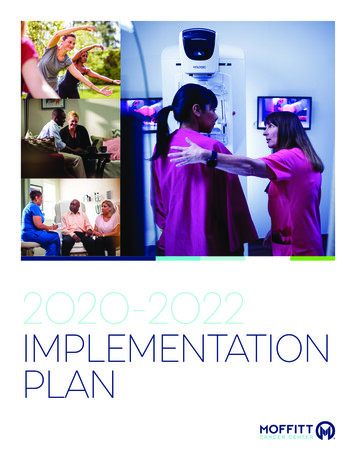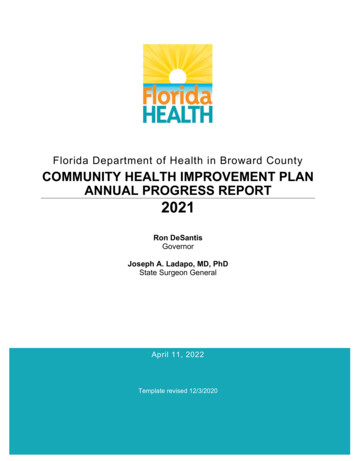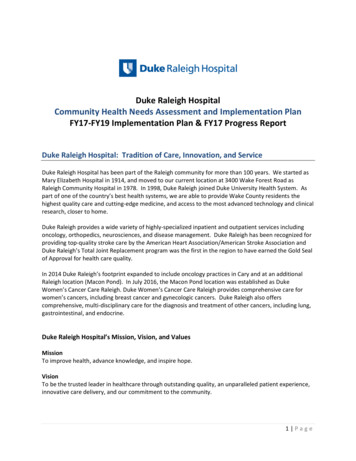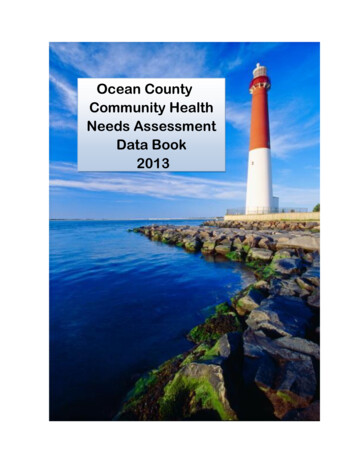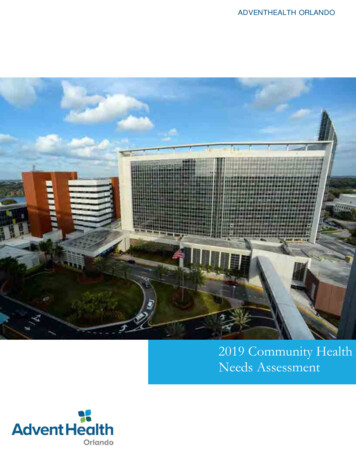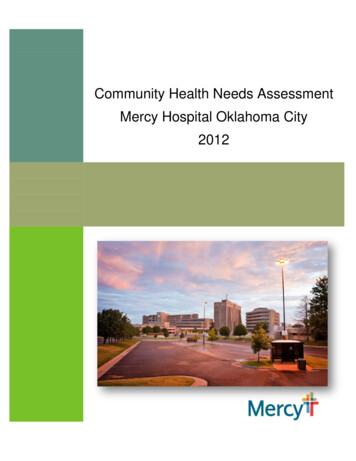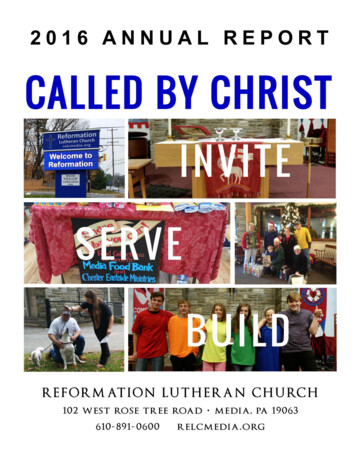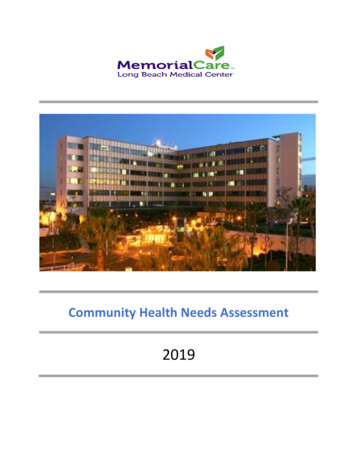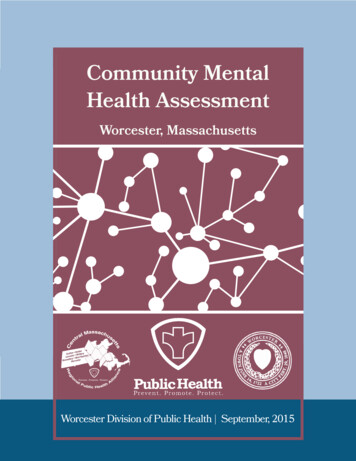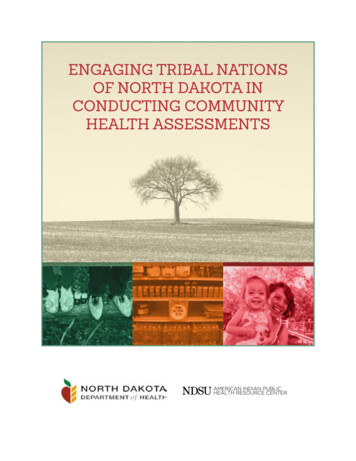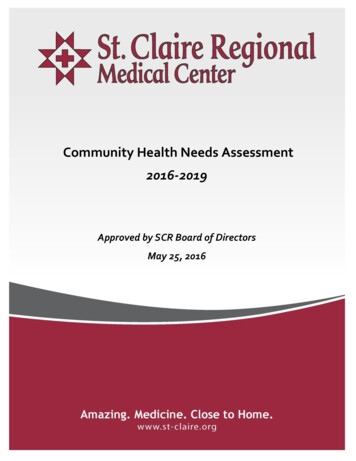
Transcription
Community Health Needs Assessment2016-2019Approved by SCR Board of DirectorsMay 25, 2016
IntroductionAs a committed community resource in northeastern Kentucky, St. Claire Regional Medical Center isdedicated to our mission to proclaim God’s goodness through a healing ministry to the people ofeastern Kentucky. Our mission remains the same after five decades of care, and we are driven toimprove the lives of the people in the region. We constantly strive to reach this goal by making healthcaremore accessible and convenient, while providing critical services. The creation of family medicine clinicsin five surrounding rural counties, and the addition of women’s imaging services serve as evidence of ourgrowth. We have also broken ground for a new 26 million, 81,000-square-foot medical services pavilion,which should be completed by the end of 2017.Our mission and values have been enhanced through community benefit programs, and those activitieshave centered on education, collaboration and improving the health and well-being of the communitiesthat we serve. The education and development of health professionals has been one of our primary focusareas for community benefit, because we believe that their training is vital to improving communityhealth. Another target area is our engagement in community support and partnerships. This engagementis realized through participation in health fairs and screenings, providing support groups, as well ascoalition building initiatives.A leading example of our focus on coalition building efforts is through the creation of the GatewayWellness Coalition (GWC). This coalition was formed in 2011 by leaders at St. Claire Regional MedicalCenter (SCR), Morehead State University (MSU) and the Gateway District Health Department(GDHD) to conduct regular community health needs assessments in four of the Gateway area counties(Bath, Menifee, Morgan and Rowan) and to identify and implement strategies and programs toaddress the most significant needs identified in those assessments.Our coalition leaders utilized the Mobilizing for Action through Planning and Partnerships (MAPP)assessment tool to guide us through the initial Community Health Needs Assessment process (CHNA).The MAPP toolkit provided our coalition with a framework for assembling organizations, groups andother key stakeholders that comprise the local public health system (See Appendix E) to create andimplement a community health improvement plan that targets services and education programs.This comprehensive process proved critical for our leaders, and the data-driven evidence it producedincreased our understanding of the complex healthcare needs and concerns of our communities. It alsoprovided our leadership with the knowledge necessary to implement successful strategies to address theidentified needs. Beyond increasing our own understanding and knowledge of the issues, the communityneeds assessment has strengthened community partnerships with many organizations.Often times, the importance of collaboration and coalition-building can be overlooked. But this processhas fostered better communication and relationships in our communities. In accordance with the InternalRevenue Code (IRC) requirements set forth in the Patient Protection and Affordable Care Act (ACA), theassessment process must be conducted every three years. From the genesis of the Gateway WellnessCoalition, our leaders’ vision has been that our assessments will be ongoing, and we will constantlyengage in data renewal and strive for improvement. The consensus has been that it is more effective,efficient and productive to base the updated assessment on the GWC’s ongoing, collaborative work anddata analysis, rather than starting again from “square one”. Most of all, this ongoing process is intricatelylinked with the SCR mission that has guided us for the past 50 years.
Our ValuesDignity – We treat each person with courtesy and respectCompassion – We serve with heartfelt care and concernExcellence – We provide care with sensitivity and professionalismCommitment – We are dedicated to quality, integrity, and responsible use of our resourcesCollaboration – We cultivate a spirit of cooperation and teamworkPhilosophyThe philosophy of St. Claire Regional Medical Center, which flows from the conviction that God is thegiver of life, is expressed through the hearts and hands of those who minister at St. Claire RegionalMedical Center.We believe that life is a sacred gift from God.Every facet of human life from conception to natural death is to be valued. Quality service and lovingcare are provided in support of life and death.We believe that the needs of the whole person, physical, spiritual and psychosocial, are to be responded to accordingto professional standards and justice.Quality services are rendered in a professional, compassionate manner with respect for the dignity of all.Sensitivity and support for the total needs of the person are integral parts of the system of care.Support for the poor and disadvantaged is pursued in all aspects of the operation of the Medical Center.We believe that the task entrusted to us brings responsibilities to share and develop.Technological resources and knowledge are applied and shared to promote health. Opportunities forgrowth through education and research are promoted. Personal and technological resources are used inan efficient manner for the benefit of all.Defining the Community ServedSt. Claire Regional Medical Center's service region is comprised of 11 counties. The Gateway AreaDevelopment District includes the majority of SCR's primary service counties (approximately 75 percentof SCR’s patient population), including Rowan County, where SCR is located. These are also the countiesserved by the Gateway District Health Department. For these reasons, the Gateway Wellness Coalitionhas decided to focus its assessment efforts on the Gateway ADD counties of Bath, Menifee, Morgan andRowan.
Input Representing the Broad Interests of the CommunityGateway Wellness Coalition Local Public Health System PartnersSt. Claire Regional Medical CenterMorehead State UniversityGateway District Health DepartmentGateway Area Development DistrictElected OfficialsBath County School DistrictMenifee County School DistrictRowan County School DistrictKentucky Department of EducationNortheast Kentucky Area Health Education CenterUniversity of KentuckyUK Extension ServiceMaysville Community and Technical CollegeMorehead-Rowan County Chamber of CommerceMorehead-Rowan County Economic Development ntucky Cancer ProgramLocal Farmers MarketsPathways Community Mental Health CenterGateway Community ActionSustainable MoreheadVeterans ClinicThe People’s Clinic – Free ClinicNew Hope Free ClinicPassport Health PlanAetnaProject WorthNortheast Kentucky Rural Health Information OrganizationMorehead Police DepartmentEmergency Medical ServicesFaith-Based OrganizationsEmployersUrban PlannersParks and RecreationU.S. Forest ServiceMorehead Fire/RescueCounty Level Steering Committees
Collaboration - Strategic PlanningFounding StakeholdersSt. Claire Regional Medical CenterSt. Claire Regional Medical Center is a medical hub serving 11 counties located in the northeasternKentucky city of Morehead. Founded on July 1, 1963, St. Claire Medical Center was created through theefforts of many people in the community, led by Dr. Louise Caudill.-The largest rural hospital in northeastern Kentucky159-bed regional referral centerSponsored by the Sisters of Notre Dame in Covington, KentuckyOver 100 physicians and surgeons representing 31 medical and surgical specialtiesMore than 1,200 employeesSecond-largest employer in the region.An established training site for the University of Kentucky College of Medicine’s physicianresidency programs11-county service region serving over 160,000 in Bath, Carter, Elliott, Fleming, Lewis, Magoffin,Menifee, Montgomery, Morgan, Rowan and Wolfe countiesReaching our communities with five family medicine clinics located in Frenchburg, Morehead,Olive Hill, Owingsville, and Sandy HookIn addition to providing services at the Medical Center’s main campus in Morehead, St. Claire Regional’soperations consist of a St. Claire Regional Outpatient Center, Cave Run Surgical Specialists, MoreheadMedical Specialists, five comprehensive family medicine clinics, a regional telemedicine system, and aneight-county home care service region comprised of home health, hospice & palliative care, and homemedical equipment. Additionally, St. Claire Regional partners with the University of Kentucky MedicalCenter to offer services through the Kentucky Clinic Morehead Cancer Treatment Center, and the UKWomen’s Center. St. Claire Regional also serves as a home for the University of Kentucky’s RuralPhysician Leadership Program, a unique program designed to train the next generation of medicalstudents for the region. Last year, St. Claire Regional provided care for the region with nearly half amillion patient encounters, and reported net revenues in excess of 130 million.SCR Representatives on the Gateway Wellness Coalition Executive Committee:-Mark J. Neff, President/CEOTom Lewis, St. Claire Foundation Executive DirectorRegina Thompson, Director of Volunteer ServicesValerie Campbell, Director of Marketing and Public RelationsMatt Watts, Business Analyst, St. Claire Medical GroupDavid Gross, Northeast Area Health Education Center DirectorCharlotte Walker, Director of Clinic Operations, Family Medicine
Gateway District Health DepartmentThe Gateway District Health Department exists to protect people's health and well-being. Through itsprograms and services, the GDHD seeks to prevent injury and illness, promote good health practices,keep the environment safe and clean, and help area residents enjoy a long, high quality, and healthy life.The GDHD offers a number of important public health services at each of its health center locations inBath, Menifee, Morgan and Rowan Counties.Services for Infant and Children’s Services include:Physicals and Development Assessments (no sports physicals)Women, Infants, and Children Nutrition Services (WIC)Healthy StartImmunizationFluorideLead ScreeningInfectious DiseaseSchool Health UnitsIn terms of Adult Services, the GDHD’s offerings include:Family planningFirst stepsCancer screeningScreening mammography referralBreast cancer programDiabetes servicesPhysical activity programPrenatal servicesPreconceptional risk assessmentCounseling, preparedness planning and readiness assessmentTobacco Education ProgramsImmunizationHealth EducationMembers who serve on the Gateway Wellness Coalition Executive Committee:-Sharon Auclerc, APRN, Director of NursingSandy Ellington, Registered Dietician (retired)
Morehead State UniversityMorehead State University has been an active partner with the Gateway Wellness Coalition, particularlythrough the auspices of the Center for Regional Engagement (CRE). The center sees itself as a thresholdinto the institution for external agencies (i.e. individual residents, nonprofit, governmental, quasigovernmental agencies, and private industry) to collaborate and partner with MSU. At the same time, wesee ourselves as an informational portal for our internal constituents (i.e. students, faculty, and staff) toidentify regional needs and provide services, resources and partner with external agencies to helpimprove the quality of life throughout MSU's service region related to community building,economic/entrepreneurial development, education, and health and wellness.- 141 undergraduate degree programs-71 graduate degree programs-Master’s degree for physician assistants, social workers, and a cooperative doctoral program, inpartnership with the University of Kentucky-Doctoral degree in Education-SACS accredited-Center for Health Education and Research-Recognized by US News and World Report as one of the top public universities in the South in the 2012edition of “America’s Best Colleges”-Driven by their goal to become the number one public university in the SouthMembers who serve on the Gateway Wellness Coalition Executive Committee:-J. Marshall, Ed.D. Executive Director for MSU’s Center for Regional EngagementLouise Cooper, Coordinator of Service Learning, MSU’s Center for Regional EngagementLucy Mays, DNP, APRN, FNP-BC, CNE, Coordinator of ADNPTimothy Thornberry, Ph.D., Assistant Professor of Psychology and Licensed Psychologist(See Appendix C for a complete list of Gateway Wellness Coalition Executive Committee members)
Executive SummaryRequirements for the Community Health Needs AssessmentThe assessment must:-Take into account input from persons who represent the broad interests of the community servedby the hospital, including those with special knowledge of, or expertise in public healthBe made widely available to the publicBe completed every three years with the first being completed no later than fiscal year 2012The assessment may:-Be based on information collected by other organizations, such as public health agencies ornonprofit organizationsBe conducted in collaboration with other organizations, including related organizations, otherhospitals, and state and local agencies, such as public health departments*Source: Kentucky Hospital Association, Community Health Needs Assessment ToolkitTo address the provisions set forth in the Affordable Care Act (ACA), St. Claire Regional Medical Centerconducted a Community Health Needs Assessment.Our process:Rather than starting from “square one” and repeating/duplicating work that was done over the past fewyears, SCR and Gateway Wellness Coalition leaders/participants determined that it would be moreefficient and beneficial to build on the solid foundation already laid by the GWC, which has includedongoing assessment of community health needs and relevant data review/analysis. The GWC structure –including an Executive Committee, county-level steering committees and health concern-specificsubcommittees – has bolstered existing partnerships and been a strong impetus for new ones to efficientlymeet the needs and requirements of the assessment process on an ongoing basis. (See Appendix C)GWC leaders have produced an updated Community Health Status Report for the GWC region and eachof the counties, providing a snapshot of what our communities look like. (See Appendix A)During the initial CHNA process, the Gateway Wellness Coalition’s committees and subcommitteesconducted county-level quality of life surveys and detailed health assessments – utilizing the Mobilizingfor Action through Planning and Partnerships (MAPP) assessment tool – compiled and reviewed datareports, and then identified crucial health needs and established goals and implementation strategies toaddress the most important health issues for each of the counties.
Since completion of the initial process, the various GWC committees and subcommittees have remainedactive in their efforts to continuously assess the community health status and needs, to implementstrategies to address those needs and to consider new strategies.In terms of availability, access and quality, these areas were identified by the community as criticallyimportant:-Community Obesity with Emphasis on Childhood ObesityAccess to Quality Health/Dental Care, Particularly for those in Poverty and the UninsuredDrug Addiction/Prescription Drug Abuse/Teen Drug AbuseEnhanced Walkability/Transportation Primarily in Remote AreasTobacco Use and CessationElder Care ServicesBased on ongoing data analyses, community-level assessments (with significant and diverse communityrepresentation on various committees and subcommittees), available resources and the effectiveness ofGWC initiatives already in place, the GWC and SCR have identified the following community healthneeds as critical focus areas over the next three years:-Community Nutrition, Recreation and Physical Activity, with Emphasis on Childhood ObesityAccess to Quality Health/Dental Care, Particularly for those in Poverty and the UninsuredTobacco Use and Smoking CessationDrug Addiction/Prescription Drug AbuseImproved health literacy will also be a point of emphasis over the next three years.The Community Health Needs Assessment will be shared with as many members of the community aspossible. Findings will be shared with key stakeholders, including our GWC committees, Chambers ofCommerce, various business leaders, and civic groups. The CHNA report will be available on thehospital website (st-claire.org) and paper copies will be offered at each of the following locations: SCRMarketing/PR, the St. Claire Foundation and SCR Administration. In addition, links to the CommunityWellness Assessment survey will be maintained, and can be found on the website.Assessing the Community’s Health NeedsTo better understand the health needs and concerns of our communities, the collection of primary andsecondary data was essential to our process. After forming the Gateway Wellness Coalition, weconducted quality of life surveys and then county-level health assessments utilizing the Mobilizing forAction through Planning and Partnerships (MAPP) assessment tool. The MAPP tool provided theframework for assembling organizations, groups and individuals that comprise the local public healthsystem to create and implement a community health improvement plan that targets services andeducation programs. We also consulted the Catholic Health Association’s (CHA) Assessing and AddressingCommunity Health Needs workbook as a guide for the methods that we implemented.Another crucial element in conducting our Community Health Needs Assessment was to identifysecondary information/data sources relevant to the health needs of each of the four Gateway Wellness
Coalition’s designated target counties. After identifying the secondary data, our team of researcherscreated a customized core indicator list representative of: demographic and socioeconomic statuses,health resources availability, health outcomes, and health rankings for the four counties. The coreindicator list aligned with the Catholic Health Association’s recommendations found in their workbook,Assessing and Addressing Community Health Needs. The final data reports included secondary data collectedfrom the following sources:Appalachian Regional CommissionBureau of Labor StatisticsBureau of Economic AnalysisCDC – National Center for Health StatisticsCommunity & Economic Development Initiative of Kentucky (CEDIK)Countyhealthrankings.orgKentucky Institute of Medicine- The Health of Kentucky: A County AssessmentKids Count Data CenterSt. Claire Regional Medical Staff Development PlanU.S. Census Bureau – American Community SurveyU.S. Census BureauU.S. Department of Health and Human Services Community Health Status Indicators ReportOur coalition formed a data collection and analysis subcommittee, which created county-specific datareports, providing a critical snapshot of the communities under study. This format has since been wellreceived, and we have enthusiastically maintained that model and have attempted to keep the data up todate over time and in the development of this updated CHNA in particular. The vast majority of the dataincluded in the updated CHNA was generated using the Community Commons CHNA ). (See Appendix A)Part of the original data collection process included the creation of a Community Wellness AssessmentSurvey (See Appendix B) to sample large numbers of community constituents. This survey featured twoparts, community need and quality of life. The community need portion focused on the three most criticalhealth problems – as well as availability, access, and quality considerations – and three areas most crucialto making the community healthier. The quality of life section asked respondents to rate their communityon a scale of one to five, including questions like “Is there economic opportunity in your county?”This survey is an efficient and effective assessment instrument, providing firsthand knowledge of ourcommunities from key stakeholders and other community members. The survey remains readilyavailable on St. Claire Regional Medical Center’s website.The results of those initial MAPP assessments and the collection and review of information/data fromsecondary sources laid the groundwork for our initial comprehensive Community Health NeedsAssessment and set a course that we have continued to follow over the ensuing three-plus years in ourefforts to continually assess and address community health needs.
Additional StepsThe Gateway Wellness Coalition Executive Committee, county-level steering committees and healthneed-specific subcommittees have remained active since their formation and continue to serve as “focusgroups” to address critical health issues and identify common community themes and strengths (SeeAppendix C). Each of these groups is vital to the ongoing efforts of the Community Health Needsassessment process.An indication of the positive impact that the GWC’s assessment, collaboration, capacity-building andstrategic implementation work has already had are the honors the coalition has received. (See AppendixH) In August 2014, the GWC received a Health Impact Award for Regional Service from the Shaping OurAppalachian Region (SOAR) organization, spearheaded by U.S. Rep. Harold “Hal” Rogers. In 2015, theGWC received the annual Community Partners Award from the Morehead-Rowan County Chamber ofCommerce, Inc.
Health Needs and Implementation Strategies
Prioritizing Health Needs and Implementation StrategiesSince their formation, the county-level steering committees and the health concern-specificsubcommittees for the Gateway Wellness Coalition have been active and have regularly monitored andevaluated the most critical areas of concern, largely supported by data and committee/subcommitteemember input. These committees and subcommittees are comprised of diverse groups of individuals,representing a cross-section of the community’s public health network.Based on this ongoing work and data analyses, the GWC has identified the following as the most criticalhealth issues and areas of concern to be addressed over the next three years and perhaps beyond:-Community Nutrition, Recreation and Physical Activity, with Emphasis on Childhood ObesityAccess to Quality Health/Dental Care, Particularly for those in Poverty and the UninsuredTobacco Use and Smoking CessationDrug Addiction/Prescription Drug AbuseOther areas of concern identified in Gateway Wellness Coalition activities include:-Health LiteracyCancer and Its CausationDiabetesHeart Disease and StrokeFamily Counseling ServicesBelow is a summary of strategies already in place or recommended to address the primary health issuesin each county, with the hope that additional funding (grants, corporate and civic group donations,combining of existing resources, etc.) can be secured to effectively implement and sustain these strategies.Rowan CountyAddressing the obesity problem in Rowan County has been identified as a high priority by the GatewayWellness Coalition. Thirty-one percent of Rowan County’s adult population is considered obese,according to the Community Health Status Indicators Report. The GWC will seek to raise obesityawareness through community events, as well as participate and encourage partnerships with theschools. It is critical that fitness programs and school-based obesity prevention interventions aremaintained for childhood obesity rates to fall.
The Robert Wood Johnson Foundation Health Group has commented on the decline of childhood obesityin some cities, and those that have experienced measurable decreases have credited an emphasis on“multiple, comprehensive programs that target both schools and communities.”Priority: Childhood and Community ObesityEmphasis: Access to Healthy Foods, Exercise and Education on Healthy LifestyleImplementation Strategies:(1) Awareness and community events. One ongoing GWC strategy is our Pediatric ObesityInitiative. This initiative was launched in April 2016 with a one-day conference on pediatricobesity. (See Appendix G) The conference was intended for medical providers, social workers,dieticians and others who work with obese children and their families. A variety of speakerscovered a broad range of issues related to the scope, assessment and management ofpediatric obesity. The conference was offered at no cost to its approximately 50 attendees,thanks to a grant from the Sisters of Notre Dame, Covington, KY Province. The intention is touse the conference as a springboard to continue working with providers to improve care forpediatric obesity, with the possibility of establishing an interdisciplinary pediatric obesityclinic.(2) Morehead was successful in seeking designation as a Kentucky Trail Town for hiking, bikingand horseback riding, with support from the GWC. GWC will continue to support efforts topromote that Trail Town designation and encourage related recreational activity.(3) School-based obesity prevention interventions that seek to increase physical activity andimprove nutrition before, during, and after school. Programs combine educational,behavioral, environmental, and other components such as health and nutrition educationclasses, encourage enhanced physical education and activities, increase availability andpromotion of healthy food options, and family education and involvement. Specificcomponents vary by program. One example of an ongoing GWC-initiated collaborativeinitiative is the “GoNoodle Plus” Program. (See Appendix G) GoNoodle helps teacherschannel classroom energy with short interactive “brain breaks”, desk-side activities that helpkids achieve more by keeping them engaged and motivated throughout the day. The GWC,SCR and Passport Health Plan have partnered to provide GoNoodle Plus in every school inthe SCR service region at no cost to the schools. As of completion of this assessment, 43percent of the eligible teachers in the SCR service region were active GoNoodle users, withmore than 7,100 students participating in GoNoodle activities. The GoNoodle Plus Projectwas honored at the November 2015 inaugural kyhealthnow School Health Program inLexington. The award was in recognition of our efforts to make schools healthier places.Another ongoing GWC strategy is the “Walking 4 Wellness” Program, which encouragesfourth-grade students to be physically active by logging how far they walk. The project hasexisted for three years and has evolved into a partnership with students in the University ofKentucky College of Medicine Rural Physician Leadership Program, based in Morehead.(4) Fitness programs in community settings, which could be offered in a variety of communitysettings including wellness, fitness, community, and senior centers. Program offerings varyby location, but often include exercise classes such as aerobic dance classes, Zumba, Pilates,and Tai Chi. In April 2016, Morehead State University employees started a “Step Challenge”
program, during which MSU faculty and staff competed against their counterparts at EasternKentucky University to see which group could finish with more steps over a five-week span.Similar competitions will be planned in the future.(5) The GWC is exploring the concept of a “Farmacy Program” in which medical providerswould have the option of prescribing fresh produce for patients who could then purchase theproduce using a token or voucher program at local farmers markets.Priority: Access to Health/Dental CareEmphasis: Those in Poverty and the UninsuredImplementation Strategies:(1) St. Claire Regional opened a new Dental Clinic in Morehead in 2013 in response to the needfor more dental services in the community.(2) Expand the University of Kentucky College of Medicine Rural Physician LeadershipProgram in Morehead– Rural training tracks and programs focus medical school training andlearning experiences on the skills necessary to practice medicine in rural communities. Theseinitiatives often recruit students from rural backgrounds and students who have expressedan interest in practicing medicine in small towns and rural locations upon completion of theirmedical training. The RPLP program has been highly successful, and plans have beenannounced to expand that program, as much as tripling enrollment in the near future.(3) The Gateway District Health Department received a grant to provide dental varnishing forstudents in grades 1-5. The GDHD hopes to secure grant funding to continue this initiative.(4) Financial incentives such as payments, vouchers, and prize drawings can be used toencourage patients to undergo preventive care such as screenings, vaccinations and otherbrief interventions. Personal incentive programs are usually offered through the public sectorand typically offer incentives to low-income individuals.(5) More strategies will be identified and implemented after the impact of the ACA on healthcareaccess and affordability becomes clearer.Priority: Drug Addiction/Prescription Drug AbuseEmphasis: Drug addiction and prescription drug abuse among teens and adultsImplementation Strategies:(1) With the loss of funding for the Rowan UNITE program – which was the community’s mosthigh-profile drug prevention organization and a GWC ally – the GWC will explore newstrategies pertaining to drug abuse awareness, prevention and treatment.(2) Pursue greater collaboration with Pathways and the Morehead Inspiration Center, aKentucky Department of Corrections residential substance abuse recovery center.(3) Educate physicians and other medical providers about warning signs of prescription druguse and appropriate ways to address it when identified.(4) Facilitate support groups such as AA, NA and ALANON.
Priority: Tobacco UsageEmphasis: Cessation programsImplementation Strategies:(1) Over the past year, the GWC Tobacco Subcommittee has consis
Wellness Coalition (GWC). This coalition was formed in 2011 by leaders at St. Claire Regional Medical Center (SCR), Morehead State University (MSU) and the Gateway District Health Department . - Sharon Auclerc, APRN, Director of Nursing - Sandy Ellington, Registered Dietician (retired) Morehead State University
